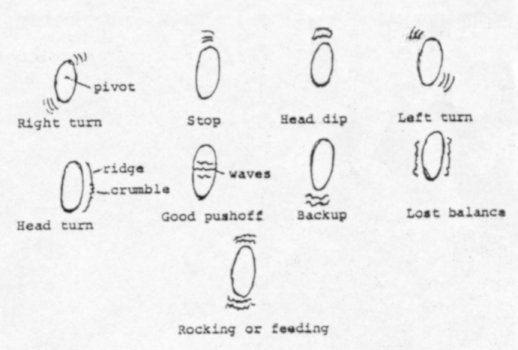Home →
Techniques →
Tracking Box
Layer Cake Tracking and Other Treats - Part 1
Brandt Morgan and the Pacific Northwest Tracker
Association
Reading the ground is a skill that can open up
worlds of joy and understanding. But, as Tom often says, there is no easy way to
learn. That's why our Tracker Association members are always on the lookout for
things that will make tracking more fun. At Buck Creek in November, Tom passed
on some new tracking methods that are both fun and fascinating - things you can
do in your own back yard, basement, or even breakfast nook.. We're eager to pass
them on to you. We hope you'll try them out, enjoy them, and learn from them as
much as we are.
The Extended Tracking Box
Dig, fluff up, and smooth out a 4x20-foot area
(smaller or larger as space permits). Or construct a box in your basement and
fill it one foot deep with wet sand. Then take turns with friends making track
patterns and trying to read them. One person might simply walk. Another might
limp or kneel to tie a shoe. A third might turn to look back as he walks, or
stumble and fall. When Tom first demonstrated this for us, the simplest actions
seemed to create impossibly complex patterns. But deciphering them was downright
exciting.
The most effective method, Tom says, is to give
each person a chance to interpret what he sees while the others stand back and
weigh the evidence. Try to stay quiet. Allow the message of the tracks to sink
in slowly without a barrage of sounds. Get a feeling of uniqueness about each
track. Ask yourself why it is like no other. Don't guess, and don't go on to the
second track until you've thoroughly studied the first one. (To avoid the almost
irresistible temptation to jump ahead, we've found it useful to cover all but
one track with a piece of opaque material.) Get down and scrutinize the track.
Look at it from six different angles, describing the disturbances and pressure
releases. Look through a magnifying glass at the caverns, cliffs, and other
formations in the footscape. Then, after the mystery of each track has been
unveiled, try to tie the pattern together. Finally, have someone re-enact the
pattern just as It was originally made.
Tom told us there are about 20 classic track
patterns in the woods and that once you are familiar with them it's much easier
to read the variations. You might try to see how many of these patterns you can
discover on your own. But you needn't limit your study to human track patterns.
Have your dog or cat pad across the box. Rent a raccoon, parrot, or goldfish.
Entice squirrels and other critters into scratching out their signatures. All
your study will add up and be stored in your subconscious for ready reference
when you need it.
Coffee Cup Tracking
If you're a frustrated tracker who is stuck at
a desk job or cramped in the confines of a hotel room, bus, or plane, try a dose
of CCT. Coffee Cup Tracking is living proof that you can practice tracking
anywhere, anytime--if you're willing to risk a little ridicule (and most
trackers are).
All you need is a coffee cup or other small
container and a few handfuls of fine wet sand. Fill the cup to the brim with
sand, smooth it over with your fingers, and pretend that your thumb is your
foot. Sounds crazy doesn't it? The point is, you can create the same general
effects with your thumb as with almost any foot, hand, or hoof. You can walk,
turn, jump, stomp, rock, twist, teeter, back up, push off, and generally cause a
real tempest in a teacup.
First, make a simple thumbprint in the sand.
With coffee cup tracking, you can look at the track from any angle and
completely control your lighting conditions by simply turning or lifting the
cup. Go through the same procedures you used for the tracking box, but in even
more detail. Look at the track, feel it, draw it. Get your eye right next to
those individual sand grains. Peer through a magnifying glass and count the
boulders knocked out of place. Become so familiar with the track that you can
see it in fine detail even when you close your eyes.
Now try another thumbprint--this time turning
your thumb a little to the left, before lifting it out, just as you might pivot
your foot to look behind you. See how the sand mounds up to the front left and
rear right? That's the classic pattern of any animal turning left. If you turn
your thumb quickly enough, your movement will even create crevasses around the
print. Study these to see which way they're trending and how far out they
extend. The more you go into detail here, the more the pattern will imprint
itself into your mind. And the more you learn from CCT, the more you'll want to
experiment with it. We caution you, however, that CCT can be addicting. You'll
know you're hooked when the waitress asks you for your order and you say,
"Just a cup of sand, please."
To get you started, here are some classic
pressure releases Tom suggested to practice and memorize.
|

From The Tracker magazine, February 1982,
published by the Tracker School.
For more articles from The Tracker magazine, visit the
Tracker Trail website |
|